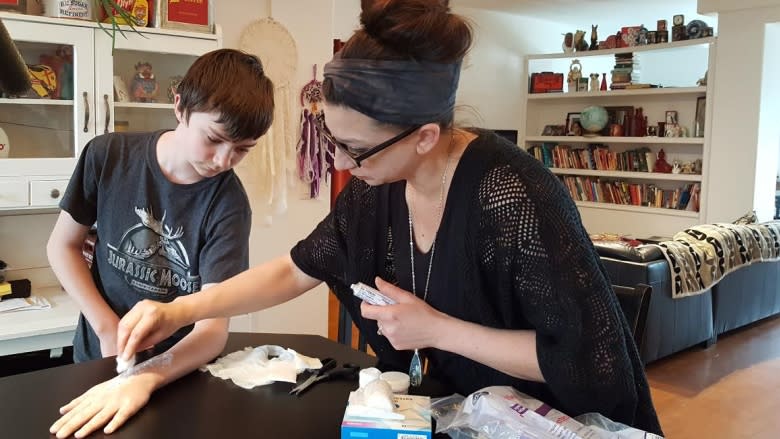Sask. mom speaks out after boy, 12, severely burned having cast removed
A Saskatchewan mother is speaking out after her 12-year-old son received severe burns while having a cast removed at a rural clinic.
Elias McWalter had been wearing a fibreglass cast on his left forearm since he fractured his thumb in a tobogganing accident in January.
On Thursday, he went to the Gama Medical Clinic in Warman, Sask. to have the cast removed with a specialized saw.
But Elias's mother Sheri Wollf said she noticed something was wrong when the doctor stopped removing the cast halfway.
'What is this?'
She said the doctor told her the saw had become too hot so he had to stop for a few minutes.
When the doctor finished removing the cast, Wollf said she saw the burns immediately.
"I asked the doctor 'What is this?' to which I was told 'It's nothing, go home, put a dressing on it'," she said.
"I'm not a medically-trained person, I could see that something was very wrong so I sought medical treatment immediately after that."
Wollf said she turned to a pharmacist in a nearby building who told her the wound would need medical treatment.
When Wollf took her son to the family doctor the next day, she said she was told Elias had suffered deep second-degree burns in two areas, first-degree burns and two blisters.
The mother and son, who live near Gruenthal, Sask., were given instructions to dress the wound three times a day.
Clinic response
Elias said he was disappointed with how the doctor handled the incident.
"Maybe if he had said something like 'OK this is not right, here, I'll help you out', then it would have been different," he said.
CBC News reached out to the doctor at the Gama Medical Clinic but did not receive a response.
The owner of the clinic also declined to comment through the front desk of Saskatoon's Taylor Street Medical Clinic, where they also practice.
'Something needs to be done differently'
Wollf said she had filed a complaint about the doctor to the College of Physicians and Surgeons of Saskatchewan.
The college said its policy prevented it from confirming the complaint.
Wollf told CBC News on Tuesday she wanted to alert others who — like her, previously — do not think there are any risks involved with the procedure.
"Something needs to be looked at, perhaps informed consent, and perhaps there's something medically that should be being done differently," she said.
"I don't know if it's equipment or training, I'm not a medical person, but something needs to be done differently, or they need to forewarn you that this is possible because he has lifelong scars now from what should have been a very, very simple procedure."
Wollf is not the first mother to speak out about the issue of burns from cast removal.
Toddler burned in Manitoba
Also on Tuesday, Lana Roulette told CBC News how her two-year-old daughter Ambriel had suffered burns and injuries during cast removal.
The mother from Sandy Bay First Nation in Manitoba said she was worried her daughter may be scarred for life.
She complained to the Portage District General Hospital where the incident occurred but said she was not told to return to the hospital to have the injuries assessed.
Unsatisfied with the hospital response, she brought her daughter to the health centre in Sandy Bay First Nation.
Assistant health director Virginia Lukianchuk said she was alarmed to see the extent of the child's injuries.
"It is unacceptable for a child to have gone through that. I couldn't believe how many burns there were," said Lukianchuk.
Injuries possible with improper technique
"It's rare, but it does happen, particularly in rural communities," according to Jeff Lambkin, a registered orthopedic technologist at Winnipeg's Grace Hospital. He said in smaller centres, there are rarely orthopedic technologists or surgeons to remove or put on casts.
Since the oscillating cast saw has a vibrating instead of a rotating blade, the skin can generally withstand contact without being cut, he said, though injuries are possible with improper technique.
"You can't drag it. If you drag it, you could burn somebody or possibly cut them," he said. "It's an up-and-down motion as you're moving along the cast from one end to the other, and that's how you're supposed to cut it off."
Injuries can also happen when an inadequate amount of cotton padding is placed between the cast and the skin when the cast is put on to begin with. Lambkin said the padding provides comfort, but also protects skin from the blade of the saw, which gets quite hot.
He said doctors should listen to their patients and stop the procedure if they report feeling pain. He'd also like to see more training for doctors, particularly in rural communities, to prevent injuries and make cast removal safer for patients.




